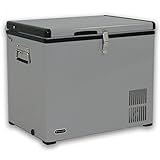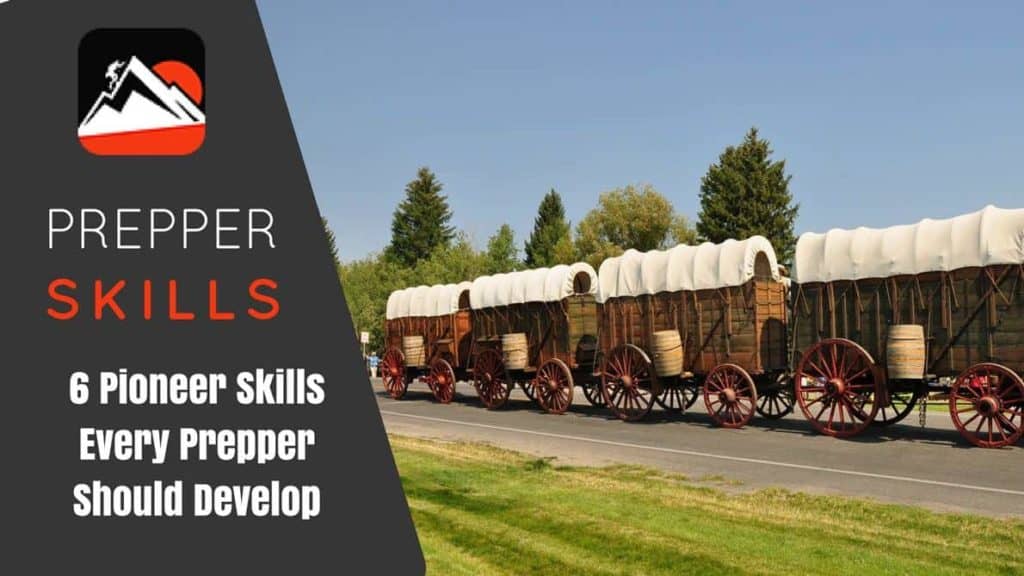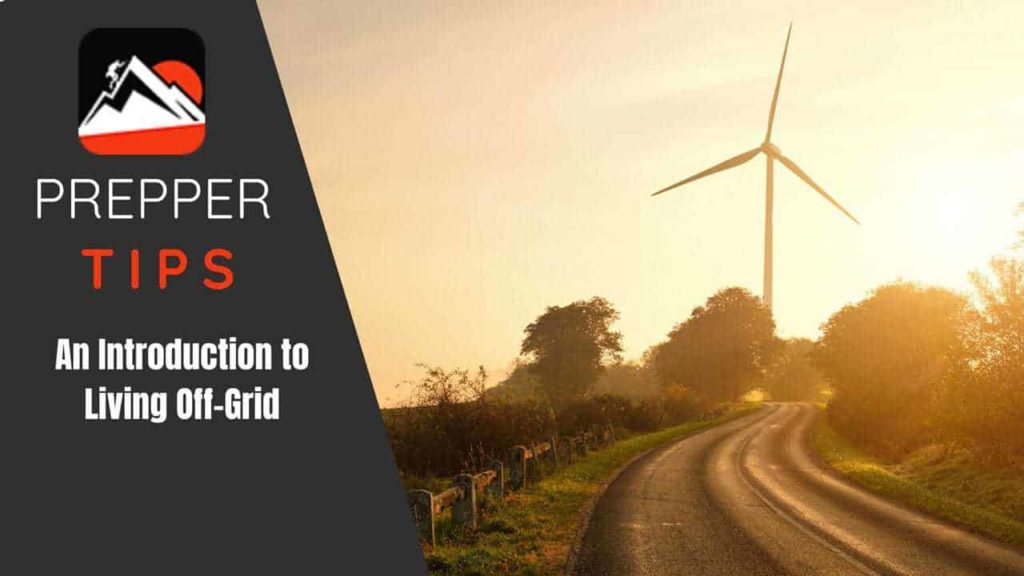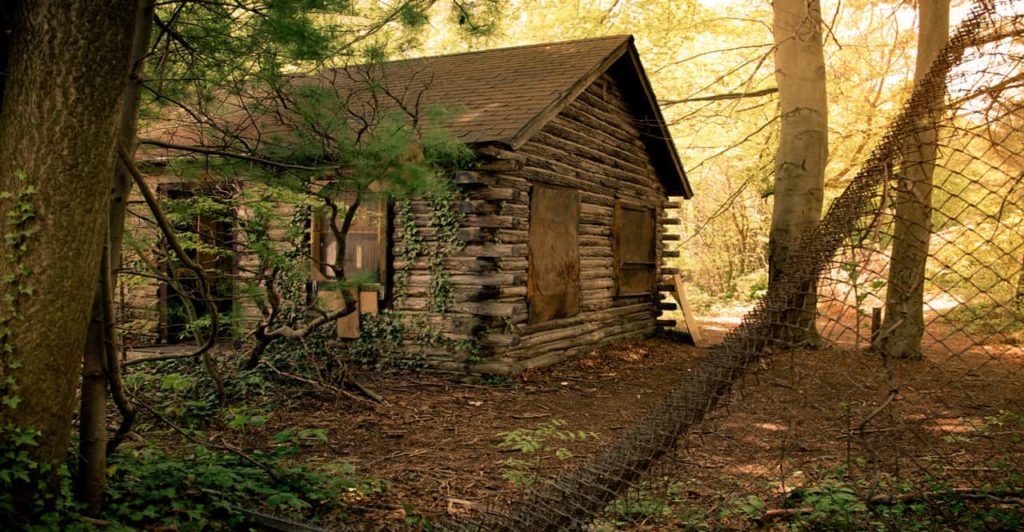Contents
No matter where you live, you’re probably accustomed to the luxury of an indoor refrigerator.
The sight of a refrigerator in a modern kitchen is commonplace, and you’d probably be surprised not to see a statuesque fridge sitting in the corner. However, that wasn’t always the case.
In fact, until 1913, there was no such thing as a home refrigerator, and it was another decade before a self-contained unit was invented.
So, if you are making the transition to an off-grid life, you’re likely wondering if you could get by without a refrigerator.
While contemporary conveniences like washers and dryers are moderately easy to do without (after all, you can harness the power of a little elbow grease and the wind to do most of the work for you), living without a refrigerator will be a bigger adjustment.
Not only is chilled food a convenience that we’ve all come to know and love, it’s also a safety issue because spoiled food is no laughing matter.
However, investing in an off-grid refrigerator can help eliminate these concerns while also allowing you to commit to a self-reliant lifestyle. Here’s everything you need to know in order to find the best off-grid refrigerator for your needs.
Best Solar Refrigerators
If you’re searching for the best solar refrigerators, the long list of options can be overwhelming. However, it’s well worth the investment; particularly if you already have solar power installed on your property.
The biggest benefit to a solar refrigerator is that, once you buy it, you won’t have to pay another cent in order to operate it because it will be powered by the sun! Here’s a quick run-down on how the technology works.
Plus, it has a USB port that enables you to charge your small electronics.
Furthermore, the AC POWER Portable Solar Refrigerator has wheels and a trolley system that make it easy to move. It can even be used inside a car, if necessary!
1. Whynter FM-45G 45-Quart Portable Refrigerator Freezer
- Convertible Small Freezer/Refrigerator: This small AC 110V/ DC 12V fridge with a 45 qt. capacity has an adjustable temperature range of -8°F to 50°F that allows you to easily change it from a compact freezer to a freezerless refrigerator and back.Refrigerant Type : R-134A
- Flexible Food Storage: This convertible refrigerator or freezer, features 2 removable wire storage baskets for added versatility and flexibility
- Fast Freeze & Consistent Temperature: Our portable fridge features an LED temperature display and a "Fast Freeze" mode that rapidly cools to -8°F
The Whynter Portable Refrigerator Freezer is another excellent option if you’re looking for the best solar refrigerator. It only weighs 45 pounds, making it one of the most lightweight and portable options you have for keeping your food cool.
With thick sidewalls, this refrigerator functions even when it’s partially tipped on its side – up to 30 degrees in fact!
It can be used as a freezer or a refrigerator (with a bonus fast-freeze setting) and comes with extra-long power cords. Plus, it has baskets that make it easier to store your food along with 45 quarts of storage space.
Solar Refrigerator Efficiency
Naturally, solar refrigerators run on solar energy. So, as long as you have an inverter that can convert DC battery power to 120-volt AC power, you’ll have all you need to keep your refrigerator running.
But, solar-powered refrigerators are more expensive upfront (even when you don’t factor in the costs of installing solar power on your property). It will require less energy and incur fewer recurring fees over time.
Best Propane Refrigerators
As with solar refrigerators, there are lots of benefits to propane refrigerators.
The best propane refrigerator will operate quietly and effectively, giving you reliable chilling power without having to worry about what will happen should the grid go down.
1. SMETA Propane Refrigerator with Freezer
- Off Grid Propane refrigerator with freezer: Equipped with an electric and propane absorption system instead of a compressor, this appliance offers efficient cooling. Approximate gas consumption per day is 0.6 lb.
- 3 Way Powered Camper Fridge: This versatile fridge operates on propane (LPG), AC110v, and DC12 volt power sources, making it perfect for various settings such as RV, off-grid living, camping, motorhome, marine vessel, and garage.
- Propane Fridge dimensions: With measurements of 20.6W*23.2D*32.2H inches, this refrigerator provides ample storage space with a capacity of 3.0 cu ft for food items and a separate 0.4 cu ft freezer compartment.
The SMETA Propane Refrigerator operates silently and can be powered by AC, DC, and of course, propane. It is available in several different sizes, which is good news if you can’t decide which size will work best for your family.
Although you can also choose from 6.1 and 9.4 cubic foot models, the 3.5 cubic foot model is one of the most popular. It can hold up to five days’ worth of food, and also has plenty of space for several items in the freezer.
It also has large storage shelves that slide out so you can keep certain foods separate from each other.
2. Smad Gas Refrigerator Freezer
- 🍦The RV refrigerator is a dual power source refrigerator that can run on both 110V electricity and propane gas. It uses the absorption refrigeration method and is completely silent with no vibrations. LPG gas pressure requirement is 2.8Kpa (28mbar).
- 🍦It has a total storage space of 9.3 cubic feet, making it suitable for storing all types of perishable goods, including tall containers, eggs, and ice cubes. The refrigerator measures 23.7 * 29.1 * 64.2 inches, making it ideal for small living spaces like boats, cabins, and RVs.
- 🍦The propane refrigerator is eco-friendly and consumes approximately 1.6 lbs of gas per day (0.38 gal per day), making it an efficient and cost-effective option for off-grid living.
The Smad propane refrigerator is a full-sized option that works well if you are living off the grid. It’s available in two supercharged sizes – 6.1 and 9.3 cubic feet.
It has four door racks, large shelves, and even slide-out trays so you won’t have to sacrifice space for efficiency.
It operates silently and is extremely high-quality. It can use either AC or propane so it’s perfect if you’re in the process of switching to an off-grid lifestyle and aren’t ready to make the full leap quite yet. It even has a full-sized freezer so you can store extra food in there, too.
Propane Refrigerator Efficiency
Propane refrigerators generally use less than half a gallon of propane each day. At an average cost of $5 per gallon, that means you will spend roughly $50 or less per month on fuel.
While that doesn’t sound like a lot, it’s a decent enough chunk of change to finance a solar set-up if you are weighing the economics.
As mentioned before, one of the biggest disadvantages to a propane refrigerator is that you will be forced to rely on an outside product.
You will need to go out for propane every now and then since you can’t produce it yourself. Plus, there’s nothing saying that propane won’t increase even more in price.
Do-It-Yourself Options
Chest Freezer Conversion: A Low-Wattage Refrigerator
If you want to live off the grid and commit to a lifestyle that produces as few emissions as possible, you might want to consider a chest freezer conversion.
You’ll need a bit of technical skill in order to make the switch, along with some parts like a temperature sensor, an external thermostat, and a few other tiny parts.
It is not time-consuming, though. A chest freezer conversion only takes about half an hour. There are a few benefits to doing this. A chest freezer has better insulating properties than the standard refrigerator, meaning it will use up less energy than a refrigerator.
Most chest freezers that are converted to refrigerators take up the same amount of energy in a whole day as a 100-watt lightbulb does in an hour. It’s simple to do and can save you some money if you already have a chest freezer lying around.
DIY Solar Powered Refrigerators
Once you think you’ve heard it all, just wait – you can even make your own DIY solar-powered refrigerator and, it’s surprisingly easy to do. For starters, all you need is an old refrigerator.
The more energy-efficient, the better. You’ll also need to have solar panels that are already installed to power your home.
Provided that you have those two elements, the next thing you’ll need to invest in is a charge controller. This will direct energy from the panels to the batteries. You should also have circuit breakers to protect your components, along with an inverter.
These circuit breakers should be dedicated, with one dedicated to your kitchen area and your refrigerator. On the panelboard, you will also need to install an automatic transfer switch that enables your refrigerator to use municipal power if your batteries are depleted.
In general, a refrigerator will consume about 30 amp-hours per day. Therefore, you’ll need enough battery storage for 90 amp-hours and solar panels that produce 80 watts or more to prevent any disruptions or problems with your DIY solar-powered refrigerator.
Although it takes a bit of handiness and technical skill to be able to build your DIY solar-powered refrigerator, there are plenty of instructions and videos available online to teach you how to do this.
AC vs DC Refrigerators: How to Choose
Many years ago, almost everyone purchased propane refrigerators if they were looking for off-grid power. This was because solar electricity was inordinately expensive and AC power inverters, too, were also expensive and relatively inefficient.
However, as solar energy becomes more efficient, DC refrigerators are becoming more popular. If you live off-grid and are truly remote, DC is your best bet because there is less chance of operator error.
Also, AC refrigerators tend to be cheaper, even when you factor in installation costs but DC systems have a lower startup wattage. DC power is suitable for appliances that need small to moderate amounts of power at all times (instead of just now and then).
One other thing to keep in mind is that some companies sell cut-rate AC refrigerator shells and plug them into DC compressors.
This will work for a bit and seem as though it is saving you money but, in reality, DC refrigerators require thicker wires.
Thus, it is inevitable that your appliance will fail as the wires are scorched. Therefore, it’s important to do your research to make sure you are really getting a good deal.
How to Choose the Best Off-Grid Refrigerator
Propane vs. Solar Refrigerators –
Before you start shopping, it’s important that you decide whether propane or solar refrigerator is right for you. While propane is a great option, the main drawback here is that you will be reliant on propane from an outside source.
Plus, propane tanks can be quite bulky, cumbersome, and difficult to come by in the case of an emergency and, regulators have also been known to freeze in very low temperatures.
Solar-powered refrigerators, on the other hand, harness the power of the sun to store electricity in your built-up battery bank.
However, while even the most efficient solar-powered refrigerator will draw quite a bit of power from your battery bank, you always have the option of only running your appliance for a few hours each day.
Size
You will need to carefully evaluate the needs of your family before you decide what size off-grid refrigerator is truly necessary.
In most cases, you’ll be able to get by with an RV or dorm-style refrigerator which will not only draw less energy, it will also be easier for you to transport.
Some Useful Refrigerator Alternatives to Consider
Zeer Pot
The zeer pot was invented in the 1990s in Nigeria. Although it sounds advanced, it’s actually a method of electricity-free refrigeration that dates back to ancient Egypt. It’s actually quite simple to make your own, too.
To do this, you’ll take clay pots and nest them, filling the gap between with wet sand. Place the food you want to keep cold in the smaller pot, then cover it with a lid. Put the pots in a shady location (ideally one with a breeze).
Shade Is important because you need the wind – not the sun to evaporate the water. This will chill the pot and can keep temperatures as low as 40 degrees!
It’s not quite as cold as a refrigerator – nor will it work well in a humid climate – but it can be highly effective. You will need to add more water (about two gallons per day) to keep it going, though.
Ice Cooler
An ice cooler is an easy solution because you don’t really have to build anything – you just have to buy one. You might have to get ice quite frequently, depending on the weather, which can be a bit of a challenge.
Plus, it can make your food soggy as the ice melts. A cooler should ideally serve as a temporary solution at best to your refrigeration needs.
Ice House
Ice houses are buildings used to store ice. They can be stored both above- and below-ground, as well as a combination of the two.
While a below-ground system will keep your ice colder, which will, in turn, keep your food colder, above-ground systems can be effective with the right insulation.
Obviously, if you live in Florida, an icehouse probably is not going to be a realistic option for you to store your food. However, if you live in a colder environment, you can get at least three or four months of cold storage from the great outdoors – all for free!
Root Cellar
Root cellars are fantastic because they require no electricity to maintain. You can store all kinds of fruits and vegetables in root cellars without having them take up space in a refrigerator. In fact, some foods store better in a root cellar than they do in the fridge!
A root cellar is an underground or partially underground storage area that can be used to store fruits, vegetables, nuts, canned goods, and other foods.
Most root cellars are built by digging into the side of a hill or digging completely underground and building a structure that is accessible via a trap door. Some people even construct root cellars out of old Conex boxes or similar repurposed items.
Just to name a few, here are some of the foods you can keep in a root cellar instead of your refrigerator:
● Potatoes
● Apples
● Garlic
● Onions
● Pears
● Winter squash
● Carrots
● Beets
● Turnips
● Parsnips
● Rutabagas
● Sweet potatoes
Root cellars were traditionally used to keep root vegetables fresh during the winter months. Many people still use them for this classic purpose, but you can also store preserved and canned food here, too.
A root cellar really only needs to be ten feet below ground to be effective, and can take the form of something as simple as a barrel or garbage can.
Here’s a video on how to set one up.
Spring House
If you’re lucky enough to have a spring on your property, you can use it to keep some items cold.
In fact, in the “olden days,” many people used to use the spring to keep milk and butter cool. It can also be used, of course, for beverages that are best served cold.
Learn Some Rural Skills
Curing Meat
Among the many rural skills you can teach yourself to learn how to live without a refrigerator, curing meat is one of the easiest. It’s a time-consuming process, but it’s easy to do.
There are several methods of curing meat that you can incorporate, including dry curing and wet curing (which involves the use of a brine).
In general, curing meat involves using a combination of sugar, salt, nitrite, and nitrate to make the food shelf-stable. Cured meat can last for several months.
Canning Food
Learning how to can is easy. Both pressure and water bath canners can be purchased inexpensively.
While pressure canners can be used to safely can just about any kind of food, water bath canners can only be used on those that are high in natural acid (like fruits and tomatoes). Most canned food lasts at least a year with no refrigeration required.
Food Dehydration
Food dehydration is another method of preservation that will allow your food to last for several months. It can be done using a store-bought dehydrator or even in an oven.
It can also be done outside, although this is more time-consuming and requires arid, warm conditions.
Store Food Wisely
No matter what kind of off-grid refrigerator you use, there are some practical tips you can follow to make the most of your space and budget. Use your space wisely.
Store leftovers for the least amount of time possible – with a little bit of creative planning, you can make it so that you never have food last more than a day or two.
You can also ditch those pre-made condiments and store-bought foods that line the doors of your refrigerator!
If you look inside your current fridge, you’ll likely notice how much space is being wasted by all those condiments you rarely need or use (after all, how often do you use that organic mango chutney from Trader Joe’s)?
When Investing in an Off-Grid Refrigerator Makes Sense
Although there are many efficient alternatives to off-grid refrigerators, sometimes taking the plunge and investing in one of these devices simply makes sense.
Choose the best off-grid refrigerator, and you won’t have to worry about your food spoiling and making you sick.
Though they will rarely be as efficient, large, and convenient as traditional refrigerators, there’s something to be said about the peace of mind that comes with having a totally off-grid way to protect your family’s food supply!







